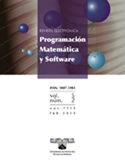Desarrollo integral de una prótesis de brazo manufacturada con tecnología aditiva y controlada por señal mioeléctrica
DOI:
https://doi.org/10.30973/progmat/2020.12.1/6Palabras clave:
Prótesis de prazo, señal mioléctrica, impresión 3D, coeficientes cepstralesResumen
Se presenta el diseño completo de una prótesis de miembro superior para una persona con lesión por arriba de codo. La prótesis está diseñada para ser impresa en su totalidad, así pueda ser reproducida y empleada con personas de bajos recursos y su velocidad de manufactura sea rápida y simple. La prótesis cuenta con diferentes accesorios intercambiables de forma que puede ser mecánica o incluir accesorios que presentan motores para su control por señales mioeléctricas superficiales. La adquisición de la señal mioeléctrica se hace mediante 4 canales diferenciales, el procesamiento en un procesador de gama alta que entrega un resultado en menos de 256ms, así como un FPGA para diferentes procesamientos alternativos para la extracción de características y clasificación. Los comandos reclutados son básicos, solo para abrir, cerrar, flexionar y extender.
Citas
Hugh Herr, G. Paul Whiteley, Dudley Childress, Cyborg Techology. Northwesthern University Technical Report. 2000.
Hugh Herr, Roy Kornbluh, New Horizonts fot orthotic and prosthetics technology: artificial muscle for ambulation. MIT Media Laboratory. 2003.
Arroyo Diaz S. 4 Channel signal based FPGA architecture for myoelectric features extraction by H.O.S. Circuits and Systems for Medical and Environmental Applications Workshop (CASME) 2011. https://doi.org/10.1109/CASME.2010.5706690
Arroyo Diaz S. Control of a Parallel Myoelectric Elbow using higher order Staristics. International Conference on Electrical, Communications, and comp. 2009. https://doi.org/10.1109/CONIELECOMP.2009.55
Laksanacharoen Sathaporn. Design of apparatus to study human elbow joint motion. Biomedical Engineering, 2003. IEEE EMBS AsianPacific Oct. 2003. https://doi.org/10.1109/APBME.2003.1302670
Murria Ingram, Garth Jonson. A study of the external forces and moments at the shoulder and elbow performing every day task, Elsevier Clinical Biomedichanics. 2004. https://doi.org/10.1016/j.clinbiomech.2004.03.004
D.J. Magermans y otros. Requirements for upper extremity motions during activities of daily living. Clinical Biomechanics No. 2 Elsevier. September 2003. https://doi.org/10.1016/j.clinbiomech.2005.02.006
Escudero A.Z., Alvarez J., Leija L. “Development and characterization of electromechanical muscles for driving transhumeral myoelectric prostheses”. Prosthetics and Orthotics International, Vol 26, Pp 226-234. 2002. https://doi.org/10.1080/03093640208726652
Escudero A.Z. & Alvarez J. Leija L. Inverse Kinematics for a parallel myoelectric elbow 23th Annual Int. Conference of the IEEE Engineering in Medicine and Biology society Oct. 2001. https://doi.org/10.1109/IEMBS.2001.1020470
Davis S. et al. Enhacen Modelling and performace in brained pneumatic muscle actuators. International Journal of Robotics Research. 2002
Alireza Khadivi “SEMG Classification for upper limb prosthetics control using higher order statistics”, ICASSP 2005. https://doi.org/10.1109/CONIELECOMP.2009.55
Kampas P. “The optimal use of myoelectrodes” MED ORth Tech 2001
Ligth C.M. Chappell P.H. ET AL. “Intelligent multifunction myoelectric control hand prostheses”. Journal of medical eng. Tech, Vol. 26 No. 4, 2002. https://doi.org/10.1080/03091900210142459
K. Englehart, B. Hudgins, P.A. Parker. “Classification of the myoelectric signal using timefrequency based representations” Medical Eng. and Physics, Vol 21 pp431-438 1999. https://doi.org/10.1016/S1350-4533(99)00066-1
Zecca M. Micera S. et al. “Control of multifunctional prosthetic hand by processing. The electromyographic signal.” Critical reviews in biomedical engineering. 2002. https://doi.org/10.1615/CritRevBiomedEng.v45.i1-6.150
G. Paraskevas et al. Study of the carry angle of the human elbow joint in full extensión: a morphometric análisis. Springer Verlag 2003. https://doi.org/10.1007/s00276-003-0185-z
Tailing B., Krivenko P., “Blast Furnace Slag- The Ultimate Binder”, Chapter 5, Waste Materials used in Concrete Manufacturing. William Andrew Publishing Noyes, 1997.
Thomas Andrew. Prosthetics principles. Atlas of Limb prosthetics. 1992
Harold Sears. Advances in arm prosthetics. Motion Control Inc. 1999.
Descargas
Publicado
Cómo citar
Número
Sección
Licencia
Derechos de autor 2020 Programación Matemática y Software

Esta obra está bajo una licencia internacional Creative Commons Atribución 4.0.
Usted es libre de:
 |
Compartir — compartir y redistribuir el material publicado en cualquier medio o formato. |
 |
Adaptar — combinar, transformar y construir sobre el material para cualquier propósito, incluso comercialmente. |
Bajo las siguientes condiciones:
 |
Atribución — Debe otorgar el crédito correspondiente, proporcionar un enlace a la licencia e indicar si se realizaron cambios. Puede hacerlo de cualquier manera razonable, pero de ninguna manera que sugiera que el licenciador lo respalda a usted o a su uso. |
| Sin restricciones adicionales: no puede aplicar términos legales o medidas tecnológicas que restrinjan legalmente a otros a hacer cualquier cosa que permita la licencia. |










